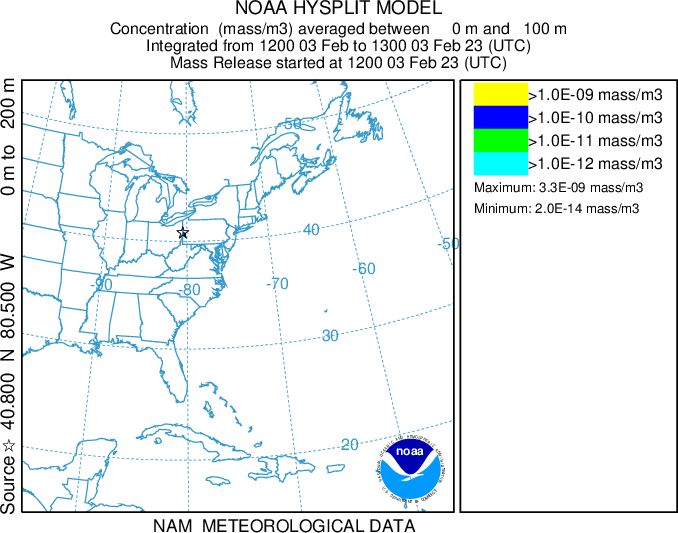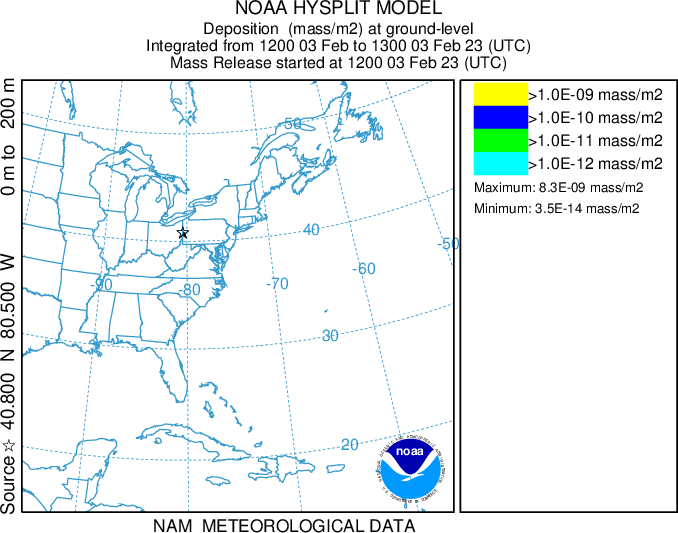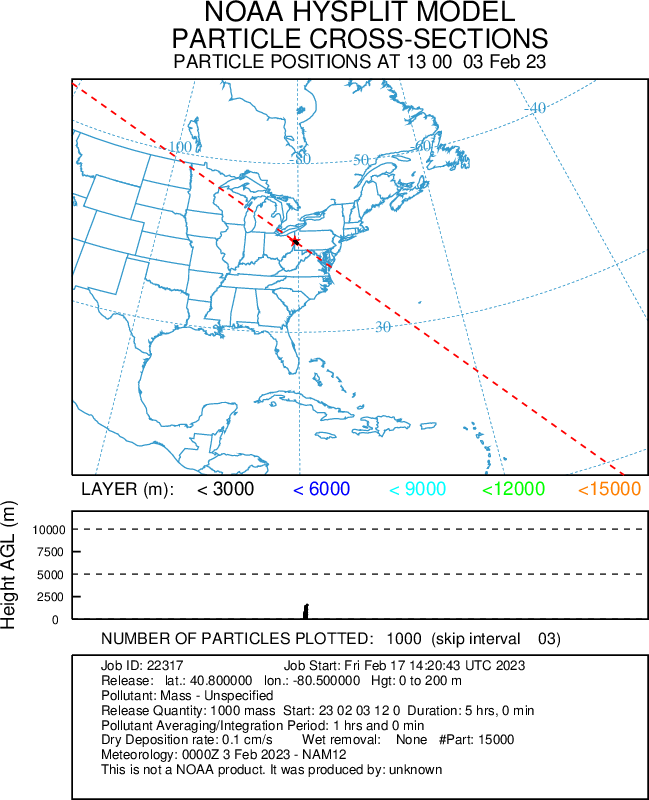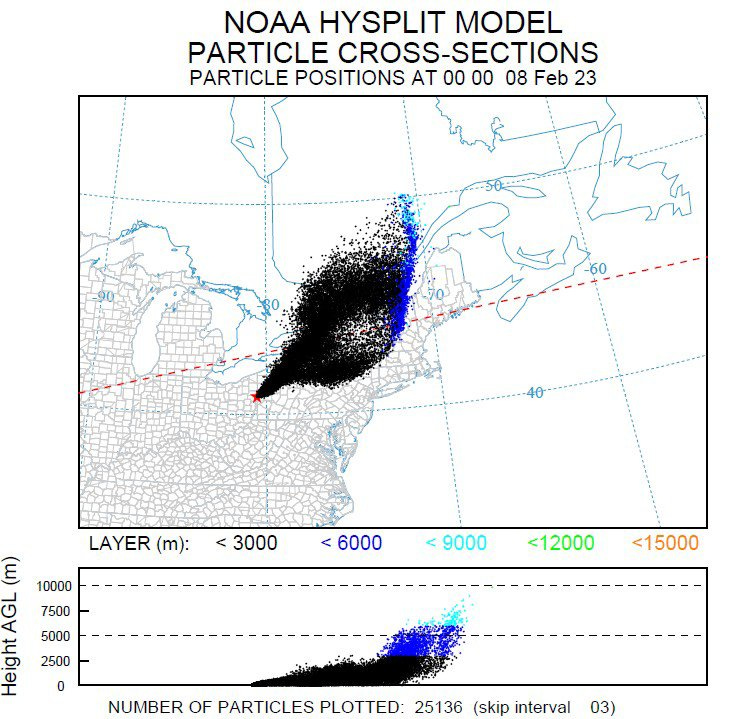East Palestine: Two Massive Ecodisasters, Not One. Where Did the Plume of Toxic Combustion Products Go, and Where Did They Settle? What Combustion Products Were Spread Across the States?
Governors of Ohio and Pennsylvania now saying it was obviously the wrong decision to burn off the chemicals. But they are blaming the railroad company.
You won't be surprised that the toxicological profiles of the chemicals that spilled and their combustion products are not all known. This is not merely a local disaster by any measure.
The mass of train cars that derailed, and the intentional burning of chemicals released in pits in East Palestine, Ohio are the nation’s greatest ecodisaster to date. But it was two disasters, not one. The train cars were carrying 1 million pounds of vinyl chloride, propylene glycol, butyl acrylate, ethylene glycol monobutyl ether, ethylhexyl acrylate, isobutylene, and benzene. The EPA has confirmed that many of these chemicals have entered the Ohio River basin, which is home to 25 million people, which is easily a regional ecodisaster. Although their preliminary report is no unsafe levels, locals have reported dead animals, from birds on power lines to dead fish floating in local tributaries. Locals have reported having to throw out personal belongings due to the intense chemical smell that lingers.
Only one of the five cars carrying vinyl chloride had breached; the others were intentionally breached, and their contents drained into pits and set ablaze. The water pollution is just the beginning. The plume of combustion products from the demolition made has created a second regional ecodisaster. Here I show according to NOAA where it went and explore the combustion products that result.
The Fallout from the Intentional Demolition
Data from NOAA’s HYSPLIT Model. Non-registered users can pull up archived results. It took me about five minutes to figure it out, here’s the link.
I managed to retrieve from the NOAA website the following .gif files using their HYSPLIT model resource. We have Concentration, Deposition, and Particle Positions images.
Annotation (From NOAA):
This is not an NOAA product. It was produced by: unknown
(NB: I have no idea why NOAA puts this on their output!)
Meteorology: 0000Z 3 Feb 2023 - NAM12
Dry Deposition rate: 0.1 cm/s Wet removal: None #Part: 15000
Pollutant Averaging/Integration Period: 1 hrs and 0 min
Release Quantity: 1000 mass Start: 23 02 03 12 0 Duration: 5 hrs, 0 min
Pollutant: Mass - Unspecified
Release: lat.: 40.800000 lon.: -80.500000 Hgt: 0 to 200 m
Job ID: 22317 Job Start: Fri Feb 17 14:20:43 UTC 2023
These images look very different from the NOAA image that was circulating earlier from 2-3 days after the derailment. I’m not sure why this image has no JobID (like mine).
I do not have the annotation file for this image and cannot vet its accuracy.
Health Effects of these Chemicals
1. Vinyl chloride (ChemicalBook.com MSDS)
Carcinogenicity
EPA: Known human carcinogen. IARC: Carcinogenic to humans.
NTP: Known to be a human carcinogen
Reproductive toxicity
Several case reports suggest that male sexual performance may be affected by vinyl chloride. However, these studies are limited by lack of quantitative exposure information and possible co-occurring exposure to other chemicals. Several epidemiological studies have reported an association between vinyl chloride exposure in pregnant women and an increased incidence of birth defects, while other studies have not reported similar findings. Epidemiological studies have suggested an association between men occupationally exposed to vinyl chloride and miscarriages in their wives' pregnancies although other studies have not supported these findings. Testicular damage and decreased male fertility have been reported in rats exposed to low levels for up to 12 months. Animal studies have reported decreased fetal weight and birth defects at levels that are also toxic to maternal animals in the offspring of rats exposed to vinyl chloride through inhalation.
STOT-repeated exposure
The substance may have effects on the liver, spleen, blood, peripheral blood vessels and tissue and bones of the fingers. Animal tests show that this substance possibly causes toxicity to human reproduction or development. This substance is carcinogenic to humans.
Aspiration hazard
A harmful concentration of this gas in the air will be reached very quickly on loss of containment.
No data available on ecotoxicity.
2. Benzene
Acute toxicityLD50 Oral - Rat - male - > 2.000 mg/kg (OECD Test Guideline 401)
Symptoms: Nausea
LC50 Inhalation - Rat - female - 4 h - 43,7 mg/l (OECD Test Guideline 403)
LD50 Dermal - Rabbit - male and female - > 8.260 mg/kg (OECD Test Guideline 402) Skin corrosion/irritation Skin - Rabbit
Result: Irritating to skin. - 4 h (OECD Test Guideline 404)
Drying-out effect resulting in rough and chapped skin.
Serious eye damage/eye irritation Eyes - Rabbit Result: Eye irritation Remarks: (ECHA)
Respiratory or skin sensitizationMaximization Test - Guinea pig
Result: negative
(OECD Test Guideline 406)Germ cell mutagenicityTest system: Salmonella typhimurium
Metabolic activation: with and without metabolic activation Method: OECD Test Guideline 471
Result: negative
Test Type: Mutagenicity (mammal cell test): chromosome aberration. Test system: Chinese hamster lung cells
Metabolic activation: with and without metabolic activation Method: US-EPA
Result: positive
Test Type: In vitro mammalian cell gene mutation test Metabolic activation: with and without metabolic activation Method: US-EPA
Result: positive
Test Type: Mutagenicity (mammal cell test): micronucleus. Species: Mouse
Cell type: Bone marrow
Application Route: inhalation (vapor) Method: OECD Test Guideline 474 Result: positive
Carcinogenicity No data available
Reproductive toxicity No data available
Specific target organ toxicity - single exposure No data available
Specific target organ toxicity - repeated exposure Causes damage to organs through prolonged or repeated exposure. - Blood
Aspiration hazard May be fatal if swallowed and enters airways.
Toxicity LD50 orally in young adult rats: 3.8 ml/kg (Kimura)
Ecological information
Toxicity
Toxicity to fish
flow-through test LC50 - Oncorhynchus mykiss (rainbow trout) - 5,3 mg/l - 96 h
(OECD Test Guideline 203)
Toxicity to daphnia and other aquatic invertebrates
static test EC50 - Daphnia magna (Water flea) - 10 mg/l - 48 h (OECD Test Guideline 202)
Toxicity to algae
static test ErC50 - Pseudokirchneriella subcapitata (green algae) - 100 mg/l - 72 h
(OECD Test Guideline 201)
Toxicity to bacteria
static test IC50 - - 13 mg/l - 24 h
Remarks: (ECHA)
Persistence and degradability
Biodegradability aerobic - Exposure time 28 d
Result: 96 % - Readily biodegradable. (OECD Test Guideline 301F)
Bioaccumulative potential
Bioaccumulation Leuciscus idus (Golden orfe) - 3 d- 0,05 mg/l(benzene)
Bioconcentration factor (BCF): 10
Mobility in soil
No data available
Results of PBT and vPvB assessment
This substance/mixture contains no components considered to be either persistent, bioaccumulative and toxic (PBT), or very persistent and very bioaccumulative (vPvB) at levels of 0.1% or higher.
Other adverse effects
Toxic to aquatic life.
Endangers drinking water supplies if allowed to enter soil or water. Discharge into the environment must be avoided.
3. Butyl acrylate
Carcinogenicity - No data available
Reproductive toxicity - No data available
Specific target organ toxicity - single exposure, Inhalation - May cause respiratory irritation
Specific target organ toxicity - repeated exposure No data available
Aspiration hazard - No data available
Toxicity - LD50 orally in rats: 3.73 g/kg (Smyth)
Ecological information
Toxicity
Toxicity to fish
flow-through test LC50 - Oncorhynchus mykiss (rainbow trout) - 5,2 mg/l - 96 h
(OECD Test Guideline 203)
Toxicity to daphnia and other aquatic invertebrates
flow-through test EC50 - Daphnia magna (Water flea) - 8,2 mg/l - 48 h
Toxicity to algae
static test EC50 - Pseudokirchneriella subcapitata (green algae) - 5,2 mg/l - 96 h
(OECD Test Guideline 201)
Toxicity to bacteria
static test EC0 - activated sludge - > 150 mg/l - 3 d
Persistence and degradability
Biodegradability aerobic - Exposure time 28 d
Result: 80 - 90 % - Readily biodegradable. (OECD Test Guideline 310)
4. Ethylene glycol monobutyl ether
Reproductive toxicity Laboratory experiments have shown teratogenic effects.
Overexposure may cause reproductive disorder(s) based on tests with laboratory animals.
“Discharge into the environment must be avoided.”
IARC: No component of this product present at levels greater than or equal to 0.1% is identified as probable, possible or confirmed human carcinogen by IARC.
Specific target organ toxicity - single exposure No data available
Specific target organ toxicity - repeated exposure Oral - May cause damage to organs through prolonged or repeated exposure. - Kidney
Aspiration hazard No data available
Additional Information RTECS: KW2975000
When ingested early symptoms mimic alcohol inebriation and are followed by nausea, vomiting, abdominal pain, weakness, muscle tenderness, respiratory failure, convulsions, cardiovascular collapse, pulmonary edema, hypocalcemic tetany, and severe metabolic acidosis. Without treatment, death may occur in 8 to 24 hours. Victims who survive the initial toxicity period usually develop renal failure along with brain and liver damage., Exposure to and/or consumption of alcohol may increase toxic effects.
To the best of our knowledge, the chemical, physical, and toxicological properties have not been thoroughly investigated.
After absorption:
agitation, CNS disorders Systemic effects:
After a latency period:
Tiredness, ataxia (impaired locomotor coordination), Unconsciousness Other dangerous properties cannot be excluded.
Ecological information
Toxicity
Toxicity to fish
static test LC50 - Pimephales promelas (fathead minnow) - > 72.860 mg/l - 96 h
Toxicity to daphnia and other aquatic invertebrates
(US-EPA)
static test EC50 - Daphnia magna (Water flea) - > 100 mg/l - 48 h (OECD Test Guideline 202)
Toxicity to algae
IC5 - Scenedesmus quadricauda (Green algae) - > 10.000 mg/l - 7 d
Remarks: (Lit.)
Toxicity to bacteria
static test EC20 - activated sludge - > 1.995 mg/l - 30 min (ISO 8192)
Persistence and degradability
Biodegradability aerobic - Exposure time 10 d
Result: 90 - 100 % - Readily biodegradable. (OECD Test Guideline 301A)
5. Ethylhexyl acrylate
Acute toxicityLD50 Oral - Rat - 4.435 mg/kg Remarks: (IUCLID)
LD50 Dermal - Rabbit - 7.522 mg/kg Remarks: (IUCLID)
Skin corrosion/irritation Skin - Rabbit Result: Irritations Remarks: (IUCLID)
Serious eye damage/eye irritation Respiratory or skin sensitization Patch test: - Human Result: positive Remarks: (IUCLID)
Germ cell mutagenicity Ames test Result: negative (IUCLID)
Result: negative (IUCLID)
CarcinogenicityIARC: No component of this product present at levels greater than or equal to 0.1% is identified as probable, possible or confirmed human carcinogen by IARC.
Reproductive toxicity
Specific target organ toxicity - single exposure May cause respiratory irritation.
Specific target organ toxicity - repeated exposure Aspiration hazard
Additional Information RTECS: AT0855000
To the best of our knowledge, the chemical, physical, and toxicological properties have not been thoroughly investigated.
ToxicityLD50 orally in Rabbit: 4435 mg/kg LD50 dermal Rabbit 7522 mg/kg
Ecological information
Toxicity
Toxicity to fish
LC50 - Leuciscus idus (Golden orfe) - 23 mg/l - 48 h
Remarks: (IUCLID)
Toxicity to daphnia and other aquatic invertebrates
EC50 - Daphnia magna (Water flea) - 17 mg/l - 48 h Remarks: (IUCLID)
Toxicity to algae
IC50 - Desmodesmus subspicatus (green algae) - 44 mg/l - 72 h Remarks: (IUCLID)
Toxicity to bacteria
EC50 - Pseudomonas putida - > 10.000 mg/l - 30 min (DIN 38412)
Remarks: (as an emulsion) (IUCLID)
Persistence and degradability
Biodegradability Result: 75 % - Readily biodegradable.
(OECD Test Guideline 301C)
Other adverse effects
Toxic to aquatic life.
Discharge into the environment must be avoided.
6. Isobutylene
“Carcinogenicity: No Data Available”
Acute toxicity
Oral: LC50 Mouse oral 415 mg/L/2 hr
Inhalation: no data available
Dermal: no data available
Skin corrosion/irritation
no data available
Serious eye damage/irritation
no data available
Respiratory or skin sensitization
no data available
Germ cell mutagenicity
no data available
Carcinogenicity
no data available
Reproductive toxicity
no data available
STOT-single exposure
Rapid evaporation of the liquid may cause frostbite. The substance may cause effects the central nervous system. Exposure at high levels could cause unconsciousness.
STOT-repeated exposure
no data available
Aspiration hazard
On loss of containment, this substance can cause serious risk of suffocation when in confined areas.
Ecological information
Toxicity
Toxicity to fish: LC50 - Fish - 22 mg/L - 96 h.
Toxicity to daphnia and other aquatic invertebrates: LC50 - Daphnia sp. - 16 mg/L - 48 h.
Toxicity to algae: EC50 - Green algae - 7.1 mg/L - 48 h.
Toxicity to microorganisms: no data available
Persistence and degradability
Isobutylene was degraded to 1,2-epoxybutane by pure cultures of methanotrophic bacteria(1).
Bioaccumulative potential
An estimated BCF of 35 was calculated for isobutylene(SRC), using a log Kow of 2.34(1) and a regression-derived equation(2). According to a classification scheme(3), this BCF suggests the potential for bioconcentration in aquatic organisms is moderate(SRC).
Mobility in soil
The Koc of isobutylene is estimated as 450(SRC), using a log Kow of 2.34(1) and a regression-derived equation(2). According to a classification scheme(3), this estimated Koc value suggests that isobutylene is expected to have moderate mobility in soil(SRC).
Health Effects of the Products of the Combustion of these Chemicals
Combustion, as solved in chemistry, is either incomplete or complete. The black clouds seen were soot (carbon), which is evidence of incomplete combustion. There are intermediate combustion products of a combustion reaction, and depending on how independent the pit burn-offs were, one might expect some on-the-ground (or in-the-ground) reactions.
Here are the combustion products that result from the combustion of these chemicals. It is not meant to be complete.
Vinyl chloride - dioxins, phosgene, hydrogen chloride (aka hydrochloric acid), benzene and unsaturated hydrocarbons (More on dioxins)
Butyl acrylate - 1‐Butene and carbon dioxide; methane, ethane, propane, butane,
ethylene, propylene, cis and trans 2‐butene, carbon monoxide.
Propylene glycol - acetaldehyde & formaldehyde
Ethylhexyl acrylate - Carbon dioxide and water (if complete combustion) plus Carbon and Carbon monoxide (if incomplete combustion)
Ethylene glycol monobutyl ether - Carbon dioxide and water (if complete combustion) plus Carbon and Carbon monoxide (if incomplete combustion)
Isobutylene - Carbon dioxide and water (if complete combustion) plus Carbon and Carbon monoxide (if incomplete combustion)
Benzene - Carbon dioxide and water (if complete combustion) plus Carbon and Carbon monoxide (if incomplete combustion)
Ohio Train Derailment: What is vinyl chloride? (newsnationnow.com)
Ohio Train Derailment Chemicals: Vinyl Chloride, Benzene Explained (insider.com)










If anyone wants to do further reading on what is behind, and underneath this, I did an ariticle on substack, here https://blaisevanne.substack.com/publish/post/103102047
Another very good one is here: https://jtrudel.substack.com/p/487cadee-2798-4300-8787-c788df71f5c4
There is MUCH more than meets the eye on this one; indeed, what just happened was Sauron-esque in its evil.
For chemical spill responses, the last thing you want to do is set it a-blaze. Containment and absorption are the first measures that are normally used. Puncturing and releasing an intact tank, is the last thing you want to do and water cooling the other tanks that are close to the burning tank are the best procedures to follow. Even with the possibility of a chemical tank exploding, you DO NOT puncture, but attempt to siphon off or reduce the pressure in the tank to prevent explosion.
This response was beyond incompetent and seems calculated to produce the worst outcomes that can be managed. The data are all over the place and the media response is not coordinated to produce a cogent story, but to muddy the water as much as possible.